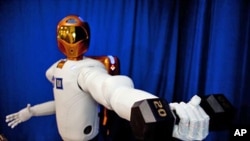The countdown is on: NASA has only two shuttle launches left. The U.S. space agency is retiring its shuttle fleet next year and encouraging the development of commercial human spaceflight vehicles.
Space shuttle Discovery is set to launch November 1
Last week, engineers found that Discovery had developed a fuel leak.
John Shannon, the space shuttle program manager at NASA's Johnson Space Flight Center in Houston, Texas, says engineers have the situation under control.
"We had a very small leak in the plumbing at a flange fitting, and the team has been working that very hard over the last week," Shannon told reporters Thursday. "We did some troubleshooting on it, and it looked like the leak stopped."
Discovery will be carrying astronauts on an 11-day mission. It will be the 35th shuttle mission to the International Space Station, or ISS.
Dan Hartman is the space station's integration and mission operations manager. He said Discovery will deliver a final piece to the U.S. segment of the ISS - the Leonardo Permanent Multipurpose Module.
"We've upgraded it and have it ready for its long duration stay on station." Hartman said. "It'll be our final module that we bring up to the International Space Station."
The new module will provide additional research and storage space.
NASA says Discovery has flown into space more than any other craft, with 38 trips and 352 days in orbit. Discovery has traveled more than 230 million kilometers and circled Earth 5,628 times since it was first launched in 1984.
The Discovery shuttle has been part of countless milestones, too. It carried the first woman to ever pilot a spacecraft, the oldest person to fly in space, the first African-American to perform a spacewalk, the first cosmonaut to fly on a U.S. spacecraft and the first sitting member of Congress to fly in space.
Discovery will end its career carrying another history-making "passenger" - Robonaut2, the first humanoid robot to fly in space.







